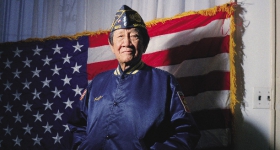AS SOON AS I BEGAN my virtual journey into the world of second Life (SL), the influence of Asian culture is undeniable. When choosing a prototype avatar, by which one explores the universe of SL, one of the options is to be a Harajuku girl or guy-complete with shredded leggings, mini-skirts and anime hair. The other avatars run the gamut from goth style to elvish, but nothing that would represent me-a medium-brown skinned South Asian woman. I could also opt out and go for something like a blue stegosaurus or a robot, but I decide to pick the "City Chic Female"-wearing a red tunic tank top over a little white t-shirt and leggings-because there is something about her skin-tone and the shape of her face that makes me think she could be hapa. I figure, I have to start somewhere.
In his comprehensive book, The Making of second Life, tech writer Wagner James Au-known as Hamlet Au in avatar formdefines SL as simply "an immersive, user-created online world." Another level in the evolution of virtual worlds, second Life was created by San Francisco-based company Linden Lab and inspired by then-CEO Philip Rosedale's trip to Burning Man-the tech arts festival in the Black Rock Desert of Nevada. And like Burning Man, second Life has slowly become one of those somewhat renegade, cultural phenomenons of the 21st Century, run out of people's bedrooms and populated by supposedly forwardthinking people who believe that virtual connectivity is the future. Not that the SL is universally loved, in fact, Time Magazine listed it as one of the top five worst websites in the world last year for its slowness and learning curve for novices.
While those who've found their footing dive in and find love, life and even careers "in world," I decide to go undercover as avatar Scherehzade Szapira to figure out how to walk in a straight line and to see if an Asian American identity-or any kind of identity for that matter-means anything when you can physically represent yourself as whatever you want.
Orientation Island: My Avatar is Insecure
It's true. Second Life isn't intuitive. I guess even Neo-the chosen one-had to train once he discovered the Matrix. I spend a lot of time on Orientation Island, the entry point into second Life, which is filled with tutorials on flying and driving and speaking. Movement is done with arrow controls on the keyboard, and most of the communication is conducted through basic chats, though you can upgrade to voice chat now.
Most of my time here is spent walking into walls and trying to make my ass bigger-most people are interested in making an idealized version of themselves when it comes to their avatars. I'm just not feeling City Chic's style. Eventually I figure out how to put on a pair of pants, but then my red tunic over cargo pants look is so 1998 that I am too embarrassed to talk to anyone once I get out into the real world. My avatar is seriously insecure.
So, instead of interviewing Au in world about his five years as a virtually embedded reporter, I meet him for lunch at Spork, a new restaurant in San Francisco's Mission District. Immediately, Au dispels any myths that second Life is full of nerds with his easygoing nature.
"The idea that I was in second Life because [I didn't] have a first life always seemed weird. I grew up in Hawaii, went surfing and did the typical Hawaii things," Au says. "But I also loved tech stuff. They were equal channels of cool experiences."
Au says he got into virtual worlds as a tech geek, but when he started writing professionally he began writing about computer games and technology from a cultural point of view. By the time Linden Lab approached Au to cover the goings-on of second Life for them, he had already been thinking about the exciting aspects of this medium.
"Also, having a philosophy degree from the University of Hawaii, I think helped," Au says. "I've always been interested in looking at political philosophy and epistemology and how they relate to online worlds and just the computer experience in general."
Au's book provides fascinating insight into what it takes to lay the groundwork for this virtual worldwhich comes down to a very careful balance of freedom and constraint. For example, Au writes that after much thought, Linden decided to limit the avatars to: "humanoid and gendered, with size limits within a realistic scale." Though residents could alter their avatars to look like a 10-foot tall robot, they have to start at this "humanoid" place and go from there, like creating an elaborate virtual costume. This restriction, Au says, forced a common identity.
When Au first joined second Life, one of his first challenges was trying to make his avatar resemble his own hapa features. "You know, change the eye shape enough for it to give it that Asian cast, the skin tone," he says. "I was impressed I was able to do that because with most online worlds you don't have the option to [be Asian]-especially if it is a Tolkien-inspired fantasy world, which is sort of assumed to be Northern European."
In his book, Au writes about a white woman named Erika Thereian who changed her blue-eyed, blonde avatar and for three months modeled "the skin of a staggeringly photorealistic, attractive young African American woman." During the three months she wore this particular skin, she faced a good deal of racismincluding being called racial epithets by strangers in world and even having her own friends distance themselves from her.
"Things like race and ethnicity are not as important in world, but they are still there," Au says. "The good thing is that people will talk about the race you select, because everything on your avatar is entirely voluntary ... anything you attribute to your avatar is something you chose to bring, as opposed to being born with all our racial and economic background, so this is a chance to choose all that."
Buying a Sexy Skin
The avatar choices had given me nothing that came anywhere near my real skin color, so I decided to invest some money-$1 US converts to $300 Linden, the currency of SL-so I could embody a body that looked more like my own and feel more confident. The most accurate skin color to my actual color that I found was labeled "sexy skin" and went for some $300 Linden. I quickly embodied it and was shocked at my virtual measurements. Let's just say that my avatar seemed to be modeled off of Barbie's black friend Devon. The biggest surprise was when I was changing into a new outfit-a denim dress bought at an SL equivalent to Ross Dress for Less for $45 Linden-and found out that my vagina was, let's just say, very real and kind of pornographic. By trying to look like myself, I seem to have embodied an avatar skin made for sex acts.
Au estimates that 40 percent of Second Life residents come in world looking for sexual activity, something that takes a lot more skill than I could even muster up-the sex on second Life comes from users hacking into animations meant for other things entirely, like riding a motorcycle. Yet when I mention the over-sexuality of my dark skinned avatar, Au says that in a skin like that, I would be pretty much asking for it.
Blogger "Diary of an Anxious Black Woman" posted last year about the experience of several young black women who were sexually harassed in second Life.
"Second Life offers individuals various opportunities to 'escape' their real lives, like creating an avatar that's not even human," she writes. "But still, what does it mean to reproduce the same experiences that one encounters offline in cyberspace, especially if someone doesn't want to escape their racial and gender identity, in fact wants to represent themselves similarly but in a digitized format?"
I wander around a bit in my low cut denim dress and boots but don't get any blatant sex offers or racial slurs aimed at me. I try to go to a club that is listed as the hottest event in SL on the search boards, but end up wandering around an empty location that resembles something out of Montego Bay, Jamaica. I also try to go surfing but end up at the Weather Channel's SL location, where some Brazilian surfers are chatting away.
Feeling lonely, I decide it's time to find what I came here for and go looking for my peoples.
Drinking Virtual Green Tea at the China Cafe
The first listing that comes up when I search for Asian American is for an APA group. The note reads: "If in Real Life, you're Asian American, Asian Pacific American, [fill-in Asian or Pacific Islander ethnicity] American, please join this group! Whether your passport says you're American or not does not matter. You do not have to be Asian (or even human in SL) to join."
After a little bit of virtual sleuthing, I track down the founder of the group and journey to talk to Ms Qunhua at the China Café, where there are koi fish and the gentle sound of pond water lapping. In real life, she is a librarian from the South who works at a university. We sit down on a bench and Ms Qunhua-a business casual dressed fox with black human hair on top of the shocking red of her facial fur-offers me tea. I can't really figure out how to pretend to drink this virtual tea, and end up crashing my SL program.
Apparently, Ms Qunhua knows this place well as she comes here for lectures/discussions with her church group-she belongs to the First Unitarian Universalist Church of second Life. Otherwise, her second Life time is spent manning the SL Reference Desk and hanging out with other SL librarians.
"I saw that African Americans and Chicanos had groups but I could not find an APA group," Qunhua tells me. "There were groups for identities but none for [blank] American."
Ms Qunhua said she was involved in a conversation one day at her second Life Church about how so few racial minorities attend Real Life (RL) churches.
"When I told them I was a racial minority, it got 'quiet' and the subject changed," Ms Qunhua says, explaining that her fox avatar hides the fact that she is Asian. By associating yourself with Qunhua's group, the title Asian Pacific American appears over your avatar's head for all to see.
When asked if creating the group has made any changes for her, Qunhua says: "At my church, someone used the term Asian Pacific American to describe an immigrant in his RL town. I thought: 'Where did he learn that term from?' "
Qunhua thought it would be cool to have monthly meetings for the APA group, which she want to model on the weekly Bisexuals of second Life meetings she used to attend, but so far the membership is too low. She's not sure why, since she is aware of other important Asian American SL residents. She thinks it also might be because only she can add new members to the group.
"Because I was not getting any requests to join, I opened the group up to everyone. One guy joined and IMed me something (inappropriate) about my Asianness," she says. Ms Qunhua ejected this person from the group, concerned he might go after other women. She has now returned the group to its original settings, where she has to approve each member.
Of all the residents I've met in SL so far, Ms Qunhua has one of the most distinctive personalities-especially with her fox avatar and her refusal to buy into the commercialism of SL (she didn't spend any Linden dollars until more than a year in the world) that I've already fallen prey to. But the low number of the Asian American group points to the fact that ethnic identity and politics don't have a solid footing in SL.
An Audience with a Watermelon Saxophone
Both Au and Ms Qunhua tell me to be sure to have an audience with Torley Linden, real name Torley Wong, while journeying across SL.
I'm wearing a slutty denim dress and hooker boots, so I decide I need to go shopping in order to be more presentable. I find the Desi Beatz Mall and shop around for an ethnically appropriate outfit. Somehow SL has made me want to be extra ethnic, which is strange since I would rarely dress like this in the real world.
I find a cream-colored, embroidered sari and decide to keep the boots and purple hair I've picked up along the way. I arrive at Torley's office, but I have a hard time finding him because today, Torley is a giant, shiny, watermelon-colored saxophone. He is seated in the middle of his equally watermelon-colored office and as we voice chat, others look on from the sides and I feel as though I am talking with some kind of royal or guru.
Perhaps guru would be more appropriate because Torley-who has been employed by Linden Labworks as the Resident Enlightenment Manager, meaning he focuses on teaching SL skills, setting up tutorials and communication about new features.
Torley joined SL in 2004, after facing some serious health issues in the RL that knocked him off his career as a techno musician. In his biography, it also lists that Torley suffers from Asperger's Syndrome, which is a form of autism that is characterized by difficulty in social interaction. So, he really blossomed in second Life, leading to his current position.
Especially since his current avatar is so out there, I ask him whether he believes that his Asian identity has any importance in SL.
"[My Asian identity] has always been a part of me," Torley says cheerfully in a Canadian accent. "It has become particularly relevant because I am descended from Chinese Hakka scholars and I now am teaching SL residents, so I feel connected to my ancestors who may have been traversing the countryside on horseback or by foot, and here I am teleporting from place to place and doing the same."
Torley says that he expresses his heritage in different ways in SL than he does in the real world and that his watermelon theme and obsession also goes back to his heritage.
"As a kid, my dad used to tell me these stories of Chinese Robin Hood-like characters. Instead of robbing the rich and giving to the poor, they'd apparently roam the countryside and then raid melon farms, taking all those watermelons and handing them out to the not-so-fortunate villages (where agriculture of such a sort couldn't be sustained, I suppose)," Torley tells me. His current saxophone avatar was given to him by an artist named Barney Boomslang. It is just one of over 100 he has, but he only actively uses some 50 of them.
"There are so many talented avatar creators," he explains.
When asked where he thinks SL will be in 10 years, Torley speaks about some basic improvements like more control of avatars and smoother technology, but it is the bigger picture that he feels most passionately about.
"Second Life will continue to help erode artificial (and stupid) barriers, empower people with limited resources to create great things (e.g. consider the cost of transport in real life compared to teleportation in SL!), and inspire hope across the globe," he says. "SL will also keep giving birth to many uses which we couldn't have anticipated, and those surprises of this evolutionary path will be among the most amazing of all."
At the end of the day, Au says that the future may be too bright to tell, but it is the everyday experiences that go beyond the confines of time, space and identity that keep him coming back for more.
"For example, last weekend, I went to see a Pakistani standup comedian who lives in Karachi. He was performing in this post-apocalyptic wasteland. So it looks like Mad Max and his avatar is a chimpanzee. He's pretty funny, talking about stereotypes of Pakistanis, that they're all terrorists, etc. So he's a Pakistani Shiite in the middle of Karachi performing live stand-up comedy in a wasteland and there are robots in the audience and there's smoke from burning trucks and stuff, so, I've never gotten tired of it, there's always so much happening."









Comments